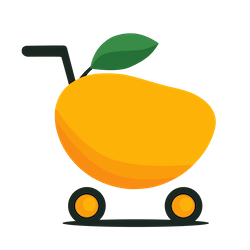You should start promoting your webinar 4 weeks in advance. Most people sign up during the final week, but a longer ramp lets you catch more signups, build trust, and avoid missing last-minute registrations. Adjust to your business, audience, and format.
–
For the 4-week promotion strategy to get more people into your next webinar, jump to this section.
The Optimal Timeline
Timing matters. Promote too early, and people move on or forget. Promote too late, and you lose busy decision-makers. If you start promoting four weeks out and keep reminding people at regular intervals, you can lift registrations by 12% (source).
Let’s put momentum into a table so you can plan what content fits each week:
| Weeks Before Webinar | Practical Actions | Effect on Signups |
|---|---|---|
| 4+ Weeks | Early bird offer, first announcement | Awareness, early buzz, a few initial signups |
| 3 Weeks | Blog/social posts, paid ad launch | Steady growth, audience starts to notice, reminders needed |
| 2 Weeks | Ramp up email, share testimonials, live Q&A | Strong conversion, audience commits and asks questions |
| 1 Week | Daily emails, countdown posts, urgency | Registration surge, urgency brings fast action |
| Event Day | Final reminders, social stories, SMS | Last-minute joiners, impulse signups |
These numbers reflect real audience behavior. Starting four weeks out means you build momentum rather than forcing decisions.
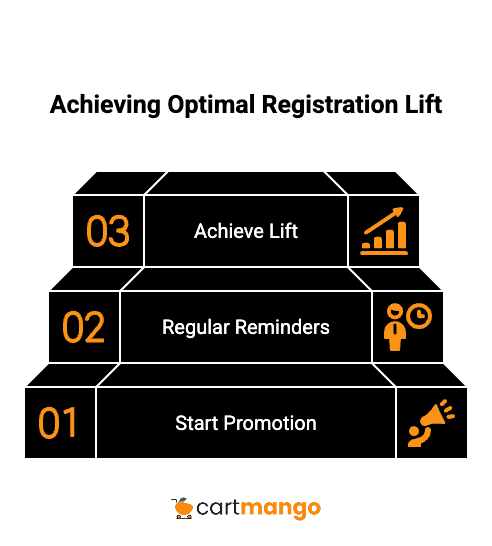
Factors That Influence Your Promotion Timeline
Not every business or offer fits the same timeline. You have to know your audience and webinar content.
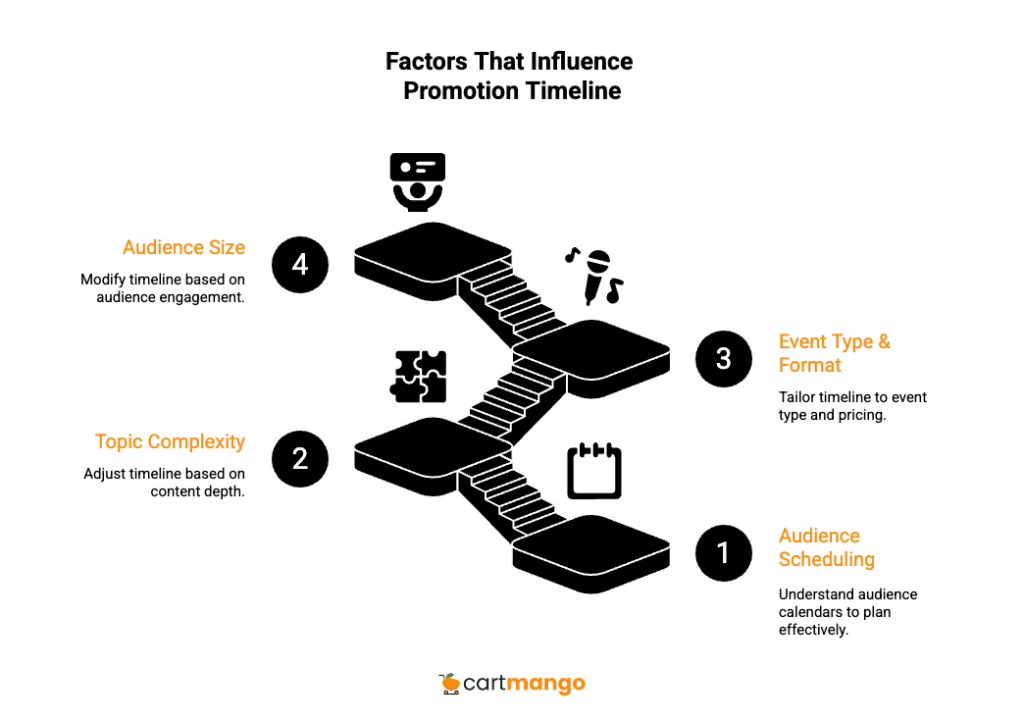
Audience Scheduling Behavior
- Busy professionals in consulting, tech, or legal need 4 or more weeks for decision-making. Their calendars fill up early.
- Solopreneurs and freelancers typically decide within 2 to 3 weeks.
- If you’re targeting small-business owners, beware school holidays and fiscal year end.
Topic Complexity
- Tactical or hands-on topics: two weeks is usually enough since people can act quickly.
- Strategic or advanced content needs four weeks. Allow time for prospects to weigh value.
- Super-niche or certification webinars may need up to two months if your audience is less engaged.
Event Type & Format
- Free, low-barrier webinars can get away with two weeks.
- Paid or premium masterclasses need at least three weeks for budgeting and comparisons.
- If you’re running a series, start six weeks out. Drip release content along the way.
- Pricing affects timing. A $19 mini-class doesn’t need as much lead time as a $399 intensive.
Audience Size
- Under 1,000 on your email list? Go for a longer ramp. People need more reminders.
- If you have an active list above 10,000, cut the prepping period down. Folks are already warmed up.
Personalize your strategy. Find out what worked for your last launch and tweak it.
4-Week Webinar Promotion Strategy
Here’s how solo digital sellers, coaches, course creators, and consultants can plan out their four-week push.
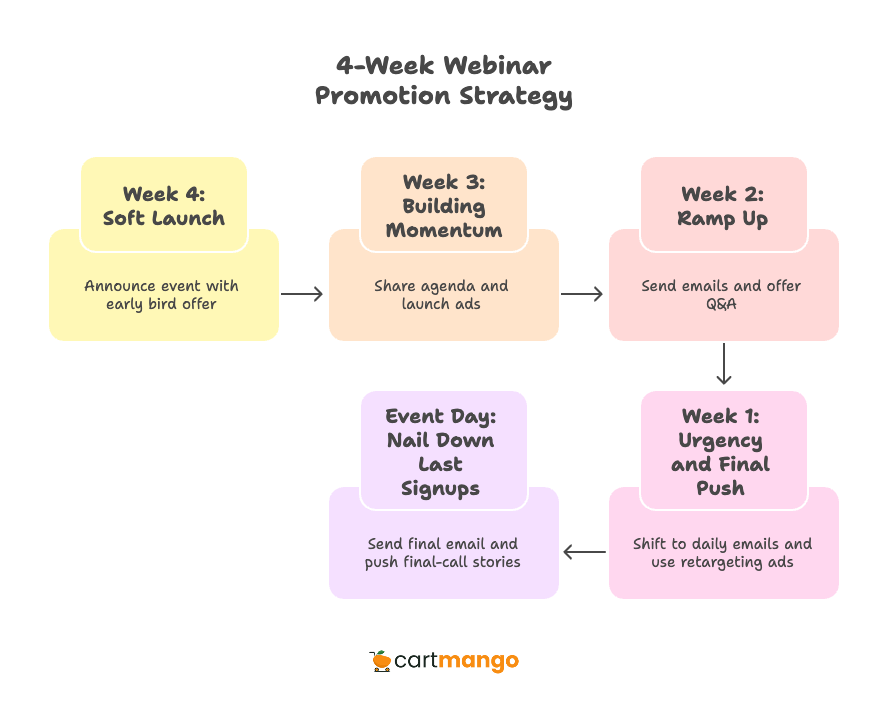
| Week | Email Actions | Social Actions | Paid Ads | Other Moves |
|---|---|---|---|---|
| 4 | Announce, offer early bird | Teaser post, save-the-date | Not required | Build landing page, create teaser video |
| 3 | Value/agenda, follow-up | Blog push, behind-the-scenes, testimonials | Start FB/LinkedIn | Ask partners to share |
| 2 | Reminders, showcase benefits | Case studies, live Q&A, countdown posts | Optimize creative | Ask past attendees to recommend |
| 1 | Daily countdown/logistics | Urgency/FOMO, daily tips/stories, final call | Retargeting | DM high-priority leads, prep assets |
| Day | Last-minute reminder | Stories, last call, “going live” posts | Not needed | SMS text nudges, “what to expect” email |
Week 4: The Soft Launch
- Announce to your email list with a bonus or early bird offer.
- Drop a save-the-date and value proposition across platforms.
- Build a landing page with registration form. Make it clean and quick.
- Create a 60-second teaser video. Spend ten minutes, not an hour. No need for high-end editing.
Week 3: Building Momentum
- Share the full agenda so non-committal leads know what to expect.
- Publish a related blog post. Link back to the registration page.
- Launch Facebook or LinkedIn ads if you have a budget.
- Reach out directly to partners, guest experts, or affiliates with prepared promo copy.
Week 2: Ramp Up
- Send two or three emails, each highlighting a different benefit or attendee outcome.
- On social, use real testimonials or snippets from last sessions. Break content up into short, punchy posts each day.
- Offer a live Q&A, either as a Facebook Live, Instagram Stories, or LinkedIn event.
- Ask previous attendees or loyal followers to share with their network.
Week 1: Urgency and Final Push
- Shift to daily emails. Each email should offer something new: tips, deadlines, reminders, bonuses.
- Social posts should be frequent. Focus on urgency: “last spots,” “only hours left.”
- Use retargeting ads if you want more reach. Keep copy brief.
- DM or email your warmest prospects with a personalized message. No blasting strangers.
Event Day: Nail Down the Last Signups
- Send an “It’s today!” email with all details covered. Log-in links, start times, what to expect.
- Push final-call Stories on Instagram, Facebook, and LinkedIn.
- SMS or text top leads if you’re comfortable.
- A five-minute “What you’ll learn” video can be recorded right on your phone.
- If you use a scheduler, turn these steps into tasks with deadlines. Ticking off each move is motivating.
Why Last-Minute Promotion Still Matters
Some registrants wait until the last minute. For all the planning, some people decide that day.
11% of people register the day of the event (source). Why do late registrations happen?
Truthfully, it doesn’t always make sense. Some people want more information. Others simply forgot. Life is busy.
Here’s how to catch them:
- Draft a “last chance” email and schedule it for the morning of your event. Say, “Still time to join us – click this link.”
- Push urgent posts across all your channels. Use Instagram Stories, LinkedIn status, and Facebook events.
- For premium or smaller events, send personal reminders by SMS or direct message.
- Keep registration open until webinar start. Zoom, GoToWebinar, and most platforms let you do this.
Don’t stress over last-minute spikes. People act fast when something’s fresh in their mind.
Common Mistakes to Avoid
Solo coaches and creators can get tripped up by hidden traps – nothing dramatic, but enough to shrink results.
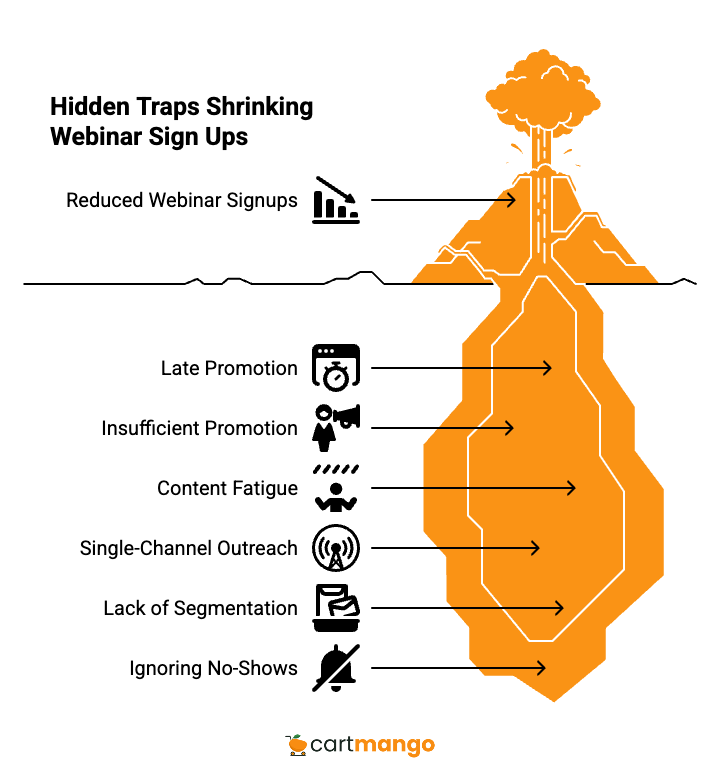
Mistake 1: Late Starts
Waiting until the last week gets your webinar in front of only the warmest audience. Fresh leads need more time to decide.
Mistake 2: One-and-Done Promotion
Informing your list or social channels just once is a recipe for obscurity. Repeat, repeat, repeat. Use variation (see repurposing table below).
Mistake 3: Content Fatigue
Promoting too early without regular follow-ups means your event drops off the radar. Spread reminders over four weeks to stay relevant.
Mistake 4: Single-Channeled Outreach
Relying on email or social or referrals alone leaves signups on the table.
Mistake 5: Failure to Segment
Sending the exact message to every list member or social follower? Big error. Tailor for different groups: repeat attendees, cold leads, past clients.
Mistake 6: Ignoring No-Shows
Don’t write off those who sign up but don’t show. Share the replay, ask for feedback, or invite them for a 1:1 follow-up.
Mistakes happen. Adjust each round and you’ll grow.
Promotion Channels
Let’s get specific about what’s actually usable for small teams or solo operators. Forget massive cross-stacks or expensive automation tools. This is about what you can practically do.
Email Marketing
- Structure announcements, reminders, and urgency emails over the whole cycle.
- Change subject lines, use preheaders, tweak formats.
- For solo creators, five to seven emails is ideal. Less and you lose traction. More, you risk burnout.
Social Media
- LinkedIn is powerful for educators, consultants, and B2B. Post regular updates, videos, and request shares.
- Instagram and Facebook make sense for course creators, fitness professionals, and personal brands.
- Don’t just post about your webinar; share related tips, polls, stories, and testimonials.
- Organize posts with a simple content calendar.
Content Ecosystem
- If you have a blog, link existing posts to your webinar registration page.
- YouTube videos: Add a line at the start or end inviting viewers.
- Podcast? Record a 30-second announcement.
Partner & Affiliate Promotion
- Find 5–10 businesses or individuals with similar audiences, not direct competitors.
- Send a ready-made blurb and image for easy sharing.
- Track which partners drive the most signups.
Paid Social Ads
- Start paid ads two to three weeks before the event to maximize effectiveness.
- Test small budgets ($5–15/day for Facebook or Instagram, LinkedIn).
- Use simple copy, clear CTA, bold images or headshots for personal branding.
Direct Outreach
- DM warm leads, recent purchasers, newsletter subscribers who clicked on past offers.
- Avoid sending cold messages to strangers.
- Personal conversations beat templates every time.
–
Track all channels. Even if one underperforms, another picks up the slack.
Content Repurposing: Maximizing Your Effort Across Channels
You don’t have capacity to invent different content for every channel.
Repurposing means adapting single pieces for email, blog, social, and video without adding more work.
Here’s how:
| Source Content | Repurpose for Email | Repurpose for Social | Repurpose for Blog | Repurpose for Video/DM |
|---|---|---|---|---|
| Announcement | Subject line and intro | Use intro/stat as post | Add as summary section | Record a quick video or story |
| Case Study | Story as nurturing email | Testimonial quote as image | Use for credibility on landing | Short highlight reel or audio |
| Countdown Email | Reminder email sequence | Split points into stories/posts | Blog recap, “1 week to go” | Short “last chance” video |
| Agenda/Benefits | Bullet points for email hooks | “What you’ll learn” posts | Break into blog sub-sections | Live Q&A on each bullet |
How do you tailor?
- Change format for channel: longer for LinkedIn, brief for Instagram, yes/no for SMS.
- Grab headline from email, use as post. Pull a quote for a Story. Turn tips into quick videos.
Repurposing is not copy-paste. It’s adapting the idea for new audiences, not creating complexity.
Troubleshooting Common Webinar Promotion Challenges
Webinar promotion can run into snags at every stage. If you notice a drop in registration and attendance, this isn’t rare.
Far in advance: Some potential attendees won’t respond to early promotion. Choosing the right timing matters – too soon and your promotion fades, too late and many people miss out.
Save the date announcements help, but build anticipation with reminders and visible webinar content.
Frequency of your promotions can impact results. If your target audience ignores your promotional efforts, increase social media posts and reminder email volume in the 1-2 weeks before your webinar date.
Use attendance data throughout your promotional period to see when people show the most interest.
Segment promotional messages by user type, topic preference, and value. Segmentation increases the chances people sign-up and keep them engaged.
If webinar registrations dip, refine your strategy, ask for feedback, or switch up visuals to reach a wider audience. Limited spots, exclusive access or influencer appearances can boost attendance.
When you’re hosting a webinar, your goal is driving registrations, not only informing. Use confirmation emails right after registration, thank-you email after the event, and ask for feedback to optimize your efforts for future successful webinars.
Sustained Engagement Post-Webinar
Webinar promotion doesn’t stop at registration. Day-of communication and post-event engagement boost ROI and keep people engaged next time.
Day-of texts and reminder emails boost attendance by reminding registrant of their commitment.
To engage your audience effectively, create a sense of urgency about limited spots, last-chance access, and valuable insights.
After someone registers, a thank-you email sets expectations and can prep for your next event.
Ask for feedback on webinar topic, speakers and panelists, user experience, and marketing strategy.
Use this information from your audience to refine your promotion efforts, build better content, and drive growth for future webinars.
Give your audience time to plan and understand the value of your webinars, and ensure your audience gets the information they need to show up.
Promotion is crucial at every step.
Ask yourself: Are you reaching your audience across various channels? Are your promotional efforts meeting the needs of your target audience?
Your Turn
Promoting a webinar isn’t about guessing the exact day people will register.
Start four weeks in advance, keep the pressure up, and scale at the right time. Most action is in the last week, but every earlier nudge counts.
Map your outreach. Balance channels, adapt messages, and reuse your own work.
Every webinar helps you improve the next. Over time, you’ll know what fits you best.
Related Readling
- SendOwl vs Gumroad: The Recurring Revenue Black Hole (2026)
- Gumroad vs Sellfy: The Vendor Lock-in Cage (2025)
- Gumroad vs Payhip: The Hidden Trap for Creators (2025)
- ThriveCart vs SamCart – The Subscription Hostage Trap (2025)
- 8 ThriveCart Alternatives & The Lifetime Pricing Paradox (2025)
- 8 SamCart alternatives + Subscription hostage (2025)
- The GENTLE Method: Soft marketing for creators
- How Far in Advance Should You Promote a Webinar?
- The SAVINGS Method: The Productivity Improvement Plan for Creators
- 9 Questions to Ask: How to Hire a Digital Marketing Agency
